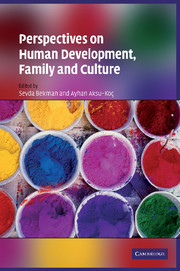Book contents
- Frontmatter
- Contents
- List of figures
- List of tables
- List of contributors
- Preface
- Foreword
- Selected international publications by Çiğdem Kağıtçıbaşı
- I Cultural and cross-cultural psychology: selected perspectives
- II Development in the family context
- III Culture and self
- IV Social change, family, and gender
- 13 One or two pathways to modernity? A systematic comparison of Kağıtçıbaşı's Model of Family Change and the Model of the Second Demographic Transition
- 14 Living together in culturally-plural societies: Understanding and managing acculturation and multiculturalism
- 15 Cultural continuity and discontinuity in Turkish migrant families: Extending the Model of Family Change
- 16 Values and attitudes of young people in urban Turkey: A further test of Schwartz's theory of values and Kağıtçıbaşı's Model of Family Change
- 17 Career development of professional women in Turkey
- V Induced change
- Epilogue
- Subject Index
- Author Index
- References
14 - Living together in culturally-plural societies: Understanding and managing acculturation and multiculturalism
Published online by Cambridge University Press: 04 August 2010
- Frontmatter
- Contents
- List of figures
- List of tables
- List of contributors
- Preface
- Foreword
- Selected international publications by Çiğdem Kağıtçıbaşı
- I Cultural and cross-cultural psychology: selected perspectives
- II Development in the family context
- III Culture and self
- IV Social change, family, and gender
- 13 One or two pathways to modernity? A systematic comparison of Kağıtçıbaşı's Model of Family Change and the Model of the Second Demographic Transition
- 14 Living together in culturally-plural societies: Understanding and managing acculturation and multiculturalism
- 15 Cultural continuity and discontinuity in Turkish migrant families: Extending the Model of Family Change
- 16 Values and attitudes of young people in urban Turkey: A further test of Schwartz's theory of values and Kağıtçıbaşı's Model of Family Change
- 17 Career development of professional women in Turkey
- V Induced change
- Epilogue
- Subject Index
- Author Index
- References
Summary
Since our first meeting at the now famous İstanbul conference on Human Abilities in 1971 (Cronbach and Drenth 1972), Çiğdem and her work have been constantly on my personal and research agenda (e.g., Berry et al. 1997; Kağıtçıbaşı and Berry 1989). Our joint concern for how to make psychological research useful to policy and program development has brought us together on numerous occasions. One occasion, which will be the focus of this chapter, was the 1997 exchange of views in Applied Psychology (Berry 1997; Kağıtçıbaşı 1997), where we attempted to bridge the positions between an avowed cultural pluralist (me), and one who saw dangers in such a world view. In this chapter, I outline my pluralist perspective, portray her concerns, and attempt to persuade her (and others) that pluralism is a reality that needs to be understood in psychological and policy terms, and then accommodated at the personal and societal levels.
Introduction
All contemporary societies are now culturally plural; no society is made up of people having one culture, one language, and one identity (Sam and Berry 2006). The prediction made over a century ago by Quincy Adams (1811; cited in Lens 1974: 3) that, “The whole continent of North America appears to be destined by Divine Providence to be peopled by one nation, speaking one language, professing one general system of religious and political principles, and accustomed to one general tenor of social usages and customs,” has not come to pass in North America, nor in any other part of the world.
- Type
- Chapter
- Information
- Perspectives on Human Development, Family, and Culture , pp. 227 - 240Publisher: Cambridge University PressPrint publication year: 2009
References
- 4
- Cited by



